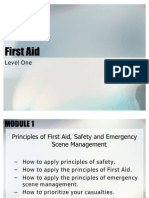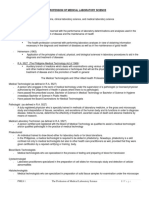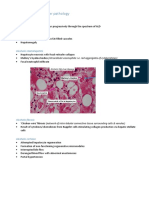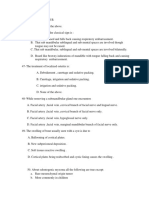Capillary Puncture Equipment and Procedure
Capillary Puncture Equipment and Procedure
Uploaded by
SiegCopyright:
Available Formats
Capillary Puncture Equipment and Procedure
Capillary Puncture Equipment and Procedure
Uploaded by
SiegOriginal Description:
Copyright
Available Formats
Share this document
Did you find this document useful?
Is this content inappropriate?
Copyright:
Available Formats
Capillary Puncture Equipment and Procedure
Capillary Puncture Equipment and Procedure
Uploaded by
SiegCopyright:
Available Formats
CAPILLARY PUNCTURE EQUIPMENT AND PROCEDURES
OBJECTIVES
At the end of the lecture, the student should be able to:
1. List and describe the various types of equipment needed for capillary collection.
2. Describe the composition of capillary specimens, identify which tests have different reference values when collected by capillary puncture methods, and
name tests that cannot be performed on capillary specimens.
3. Identify indications for performing capillary puncture on adults, children, and infants.
4. List the order of draw for collecting capillary specimen
CAPILLARY PUNCTURE EQUIPMENT ๏ Sealants:
- Blood collection supplies and equipment has been discussed previously - Plastic or clay
- Used to seal one end of
1. Lancets/Incision Devices the microhematocrit
- Sterile, disposable, sharp-pointed or bladed instrument that punctures tubes
or makes and incision in the skin to obtain capillary blood
2. Laser Lancets 5. Capillary Blood Gas Equipment
- Uses laser instead of a sharp instrument to produce a small hole in the ๏ CBG collection tubes
capillary bed without cauterizing delicate capillaries - Long thin narrow-bore
- Recommended for adults and children 5 years and above capillary tubes that are 100 mm in length with a capacity of 100 uL
- Color-coded to identify the type of anticoagulant that coats the
inside of the tube (green: sodium heparin)
๏ Stirrers
- Small metal filings (referred to as ‘fleas’) or small metal bars
inserted into the tube after collection of a CBG specimen
- Used to aid in mixing the anticoagulant with the specimen
๏ Magnet
- Both ends of a CBG tube are sealed immediately after specimen
collection to prevent exposure to air
3. Microcollection Containers - Used to mix the specimen
- Also known as microtainers/microtubes
- Some are fitted with narrow plastic capillary tubes to facilitate ๏ Plastic caps
specimen collection - Closures used to seal CBG
- Have color-coded bodies or stoppers that correspond to color-coding tubes and maintain anaerobic
of ETS blood collection tubes, and markings for minimum and conditions
maximum fill levels measured in microliters (uL)
6. Microscope Slides
- Used to make blood films for
hematology determinations
(peripheral blood smear)
7. Warming Devices
- Increases blood flow
- Important when performing
heelsticks on newborns
- Provide a uniform temperature that does not exceed 42OC
- Alternative: towel or diaper dampened with warm tap water
4. Microhematocrit tubes and sealants
- Disposable, narrow-bore plastic or plastic-clad glass capillary tubes COMPOSITION OF CAPILLARY SPECIMENS
that fill by capillary action - Blood obtained by skin puncture is a combination of blood from capillaries,
- Hold 50 to 70 uL of blood arterioles and venules, along with interstitial fluid (fluid in the spaces
- Used for manual hematocrit (Hct) or packed cell volume (PCV) between the cells) and intracellular fluid (fluid within the cells) from the
determinations surrounding tissues
- Coated with ammonium heparin (red band): collecting Hct tubes - Capillary specimens resemble arterial blood than venous blood (most
directly from a capillary puncture specially if the area is warmed)
- Plain (blue band): used when a Hct tube is filled with blood from a - The first drop of blood will be diluted by interstitial fluid upon puncture,
lavender-top tube therefore the first drop of blood needs to be wiped prior to collection.
✓ Reference Values
- May be different from that of venous blood because of the difference in
composition
- Higher in capillary blood: glucose, hemoglobin, potassium (serum)
- Higher in venous blood: calcium, total protein, potassium (plasma)
- It is important to note that samples were collected via skin puncture
katbugante-pascua PMLS 2 LECTURE 1 of 3
CAPILLARY PUNCTURE EQUIPMENT AND PROCEDURES
✓ Tests that cannot be Performed on Capillary Samples ‣ Pinky: The tissue between skin surface and bone is thinnest in
- Blood culture this finger, and bone injury is likely
- Routine coagulation tests requiring plasma
- Erythrocyte sedimentation rate
- Tests that require large volume of serum or plasma samples CLSI: Capillary puncture MUST not be performed on the fingers or
earlobes of newborns or other infants under 1 year of age.
✓ Indications for Capillary Puncture
- In several situations, a properly collected capillary specimen may be - Precautions:
preferred over venipuncture when small amounts of blood are ‣ Do not puncture fingers of infants and children under 1 year of
acceptable for testing age because the amount of tissue between the skin surface and
- These situations may arise when: bone is so small that bone injury is very likely.
‣ The patient is an infant, and a good vein is not found ‣ Do not puncture fingers on the same side of mastectomy without
‣ The patient is a small child, and either a proper vein is not found consultation with the patient’s physician. The arm on the same
or the child will not cooperate with the venipuncture side of mastectomy is susceptible to infection, and effects of
‣ Tests that are ordered require only a few drops of blood lymphostasis can lead to erroneous results
‣ The patient is very apprehensive about a venipuncture and insists ‣ Do not puncture parallel to the grooves or lines of the fingerprint
on a skin puncture (parents can also request this procedure for for this will allow blood to run down the finger rather than forming
their child) a rounded drop.
‣ Repeated venipunctures are not successful ‣ Do not puncture the side or very tip of the finger because the
‣ The patient is obese distance between the skin surface and the bone is half as much at
‣ The patient has severe burns the side and tip as it is in the central fleshy portion of the end of
‣ The patient has thrombotic tendencies the finger.
‣ The patient’s veins must be reserved for therapeutic purposes like ‣ Edematous (swollen) sites should be avoided because a free flow
intravenous lines of blood is impossible
‣ The patient has fragile superficial veins ‣ Cold or cyanotic areas should also be avoided because blood
‣ To obtain blood for POCT procedures like glucose monitoring obtained from these sites may result in falsely high hemoglobin or
cell-count values
✓Infants have a small blood volume, removing quantities of blood
typical of venipuncture or arterial puncture can lead to anemia
(for every 10mL of blood removed, as much as 4mg of iron is also
removed.
✓ Large quantities removed rapidly can cause cardiac arrest. Life
is threatened if more than 10% of the patient’s blood volume is
removed at once over or over a short period.
✓ Obtaining blood from infants and children by venipuncture is
difficult and may damage veins and surrounding tissues.
✓ Puncturing deep veins can result in hemorrhage, venous
thrombosis, infection and gangrene.
✓ An infant or child can be injured by the restraining method used
while performing venipuncture.
✓ Capillary blood is the preferred specimen for some tests like Puncture should be made perpendicular to the fingerprint
newborn screening tests. which will cause the blood to form a droplet.
- Capillary puncture is NOT appropriate when: ✓ Infants (<1 year)
‣ The patient is severely dehydrated - Site of collection for capillary puncture is
‣ The patient is in shock the heel specifically the lateral or medial
‣ The patient has chronic poor circulation area of the plantar (sole) surface of the
‣ The patient is extremely cold heel (see image)
‣ More blood than can be obtained by a skin puncture is needed for - It must be in an area where there is little
testing risk of puncturing the bone causing
osteomyelitis (inflammation of bone
✓Capillary puncture is generally not appropriate for patients who marrow and adjacent bone), or
are dehydrated or have poor circulation to the extremities from osteochondritis (inflammation of the bone
other causes (mentioned above) because specimens may be hard and cartilage as a result of infection)
to obtain and may not be representative of blood elsewhere in - Precautions:
the body. ‣ Do not puncture any
deeper than 2.0 mm
SITE SELECTION because of the risk of
injuring the bone Use this phrase to remember safe
- Performed on fingertips, heels, toes or earlobes
- Earlobe is not recommended as site of choice due to poor capillary access ‣ Do not puncture areas for heel puncture:
areas between the “Make Little People Happy.”
imaginary M for medial, L for lateral, P for plantar
✓ Children and Adults boundaries and H for Heel. 🙃
- Generally, the finger of choice are the middle or ring fingers of the non- ‣ Do not puncture in
dominant hand the arch and any areas
- The thumb, index finger and pinky are not appropriate choices for of the foot other than the
capillary puncture heel. Arteries, nerves, tendons and cartilage in these areas can be
‣ Thumb: It has a pulse, indicating an artery in the puncture area; injured
skin is generally thicker and more calloused ‣ Do not puncture severely bruised areas because it is painful and
‣ Index finger: It is more calloused and harder to puncture; it is impaired circulation or byproducts of the healing process can
more sensitive so the puncture can be more painful; it is used negatively affect the specimen
more, the patient may notice the pain longer
katbugante-pascua PMLS 2 LECTURE 2 of 3
CAPILLARY PUNCTURE EQUIPMENT AND PROCEDURES
‣ Do not puncture the posterior curvature of the heel because the 18.Gently tap the microtainer tube periodically to mix blood with the
bone can be as little as 1.0 mm deep in this area anticoagulant.
‣ Do not puncture through previous puncture sites because not only 19.If filling capillary tubes or microhematocrit tubes, fill the tube approximately
is this painful it can spread previously undetected infection 2/3 full and seal with the appropriate sealing compound
‣ Do not puncture a swollen site because excess tissue fluid in the 20.Slide your hand to the base of the patient’s finger. Gently ‘milk’ the patient’s
area could contaminate the specimen finger by firmly sliding your hand grasp back toward the patient’s fingernail
21.Do not squeeze excessively. This could result in contamination of the
ORDER OF DRAW specimen with interstitial fluid. Allow the blood to flow freely into the tube.
- Not the same as venipuncture Do not ‘scoop’ the blood into the tube which forces fluids into the specimen
- Puncturing the skin releases thromboplastin that activates the coagulation 22.When the collection device is sufficiently filled, place a clean, dry piece of
process in the blood drops gauze over the puncture site. Have the patient apply pressure until
- Specimens must be collected quickly to minimize the effects of platelet bleeding has stopped. Do not use a bandage on the finger of a toddler
clumping and micro clot formation and to ensure that an adequate amount which causes choking. Instruct the patient when to remove bandage.
of specimen is collected before the bleeding stops 23.Mix all collection devices containing anticoagulant
- Hematology specimens are collected first since they are most affected by 24.Dispose of all contaminated equipment (bloodied gauze) in a biohazard
the clotting process container
- Serum specimens are collected last 25.Label specimen containers with appropriate information to ensure
✓ Slide for differential or stain identification of the specimen
✓ Blood gas specimens (CBGs) 26.Remove gloves and dispose of them in a designated container to prevent
✓ EDTA specimens contamination of the patient area
✓ Other additive specimens 27.Wash hands
✓ Serum specimens
PERFORMING A HEELSTICK/ HEEL
PREPARING THE SITE PUNCTURE
- A free flow of blood is important for accurate test results - Requires extra care and attention
- Massage the finger of the adult or child and the heel of the infant until the - Collecting blood samples in the hospital nursery requires the use of
skin is pink (stimulate circulation) isolation techniques
- Warming the skin will also increase blood flow which is applied for at least - Never take a collection tray into the nursery
3 minutes - Wash hands thoroughly
- Put on a longed-sleeved gown and mask, if required (follow all nursery
protocols for interacting with infants)
The temperature of the material used to warm the site must not
exceed 42OC, because higher temperatures can burn the skin,
1. Identify the infant
especially that of infants.
2. Assemble supplies. Heelstick and fingerstick supplies are similar. However,
a short-point lancet of less than 2.0mm must be used for the heel stick to
PUNCTURE DEPTH AND WIDTH avoid bone damage. Open the gauze, alcohol prep pad and lancet
- Depends on the site and the patient packages, but leave items inside the packages
- To minimize the risk of inflammation and infection, the lancet should never 3. Put on gloves
penetrate more than 3.0mm (fingerstick) 4. Warm and/or gently massage the heel
- Heelstick, maximum depth is 2.0mm, because the calcaneus (heel bone) 5. Select appropriate puncture site, avoiding previous puncture sites and the
can lie very close to the surface curvature of the heel
- Premature babies: 0.65mm to 0.85mm 6. Grasp the infant’s foot firmly. A firm hold will prevent sudden movement.
Place your forefinger over the arch of the baby’s foot and your thumb
below the puncture site. Your remaining fingers should rest on top of the
PERFORMING A FINGERSTICK/CAPILLARY infant’s foot. The baby’s foot will be resting between your index finger and
PUNCTURE third finger
7. Cleanse area with an alcohol prep pad. Allow to dry
1. Wash hands and apply gloves 8. Puncture the skin (perpendicular to the heel print) in a quick, firm, down-
2. Observe patient courtesy and up motion.
3. Introduction of the phlebotomist, identification of the phlebotomist’s identity, 9. Wipe away the first drop of blood
patient identification and explanation of the procedure 10.Fill the appropriate collection device/s (observe order of draw)
4. Patient preparation: Position the patient 11. When the collection device has been filled appropriately, elevate the
5. Equipment preparation infant’s foot, place a clean gauze over the site, and press firmly until
6. Site selection bleeding stops
7. Selection and assembly of puncture equipment 12.Mix collection devices with anticoagulant
8. Select puncture site 13.Label specimens
9. Ensure the patient’s hand is warm and relaxed and ensure the patient is 14.Dispose of contaminated equipment properly
comfortably seated. Gently massage the finger towards the tip to increase 15.Remove gloves and place in designated disposal units
blood flow 16.Assess the newborn (return to parent or guardian if outpatient collection is
10.Disinfect and thoroughly dry the puncture site done)
11. Remove cover from lancet or other device to be used
12.Grasp patient’s finger, placing your thumb at the base of the fingernail. References:
Wrap your fingers around the inside of the patient’s finger WHO guidelines on drawing blood: best practices in phlebotomy, 2010
13.If using a lancet, make a quick down-and up motion with the lancet to firmly Clinical and Laboratory Standards Institute: Collection of Diagnostic Venous
puncture the skin Blood Specimens, 7th Edition, 2017 The Phlebotomy Textbook by Susan King
14.Dispose of the lancet in a sharps container Strasinger, Marjorie Schaub Di Lorenzo. -- 3rd Edition., 2011
15.Squeeze the patient’s finger gently to stimulate release of one drop of Applied Phlebotomy, Dennis Ernst, 2005
blood The Complete Textbook of Phlebotomy, Lynn B. Hoeltke, 2019
16.Wipe the first drop of blood with gauze, cotton or filter paper
17.Again, gently squeeze the patient’s finger and fill the collecting device/s
(observe order of draw)
katbugante-pascua PMLS 2 LECTURE 3 of 3
You might also like
- Unit 1 Principles of Medical Laboratory ScienceDocument11 pagesUnit 1 Principles of Medical Laboratory ScienceMinecraft ChickNo ratings yet
- Principle of Medical L Aboratory Science Practice 2: Pmls 2Document29 pagesPrinciple of Medical L Aboratory Science Practice 2: Pmls 2Justine Mae Lerios100% (6)
- Medical Technology Laws PDFDocument153 pagesMedical Technology Laws PDFKami TazuNo ratings yet
- RA 4688 (Clinical Laboratory Law)Document7 pagesRA 4688 (Clinical Laboratory Law)Danielle Anne Zamora-Matillosa Lamban100% (1)
- History of Med Tech (PPT 1)Document29 pagesHistory of Med Tech (PPT 1)Christopher CaduhadaNo ratings yet
- Lesson 6 PMLSDocument11 pagesLesson 6 PMLSSheen Gabato100% (2)
- PMLS Midterm ReviewerDocument41 pagesPMLS Midterm ReviewerGwen Yosheen100% (1)
- PMLS 2 ReviewerDocument8 pagesPMLS 2 ReviewerNepoy Beltran Entendez100% (3)
- Ao 31 S 1979Document6 pagesAo 31 S 1979Ai NaNo ratings yet
- Principles of MLS 2 LECDocument45 pagesPrinciples of MLS 2 LECSab ParkNo ratings yet
- Capillary Puncture Equipment and Procedure PDFDocument23 pagesCapillary Puncture Equipment and Procedure PDFCamille QuiaoitNo ratings yet
- PMLS2 Understanding Phlebotomy ReviewerDocument5 pagesPMLS2 Understanding Phlebotomy ReviewerShane G.No ratings yet
- Seminar ActivityDocument2 pagesSeminar ActivityStephen YorNo ratings yet
- WEEK 1 Safety, Quality Assessment and Laboratory OperationDocument8 pagesWEEK 1 Safety, Quality Assessment and Laboratory OperationDayledaniel SorvetoNo ratings yet
- PMLS 1 1ST Semester Prelim NotesDocument8 pagesPMLS 1 1ST Semester Prelim NotesLol lolNo ratings yet
- RA 5527 & Amendments 2017-18Document50 pagesRA 5527 & Amendments 2017-18John Phillip Dionisio67% (3)
- Pre-Test NAME: JAVIER, Cziarlene Jhoy B. SCORE: - Section: Mls 1-4 DATE: September 3, 2020Document2 pagesPre-Test NAME: JAVIER, Cziarlene Jhoy B. SCORE: - Section: Mls 1-4 DATE: September 3, 2020Mav JavierNo ratings yet
- Chief Medical Technologist and Senior Medical Technologist PresentationDocument21 pagesChief Medical Technologist and Senior Medical Technologist PresentationErl Bryan Fisco100% (2)
- PMLS 1 Lesson 8 Nature of Clinical LabDocument200 pagesPMLS 1 Lesson 8 Nature of Clinical Labangelica faye100% (1)
- PMLS Reviewer For Midterms PDFDocument14 pagesPMLS Reviewer For Midterms PDFJerica Mae Gabito100% (1)
- 3 - RA4688 Clinical Laboratory LawsDocument4 pages3 - RA4688 Clinical Laboratory LawsMorticia VizactyhNo ratings yet
- Chapter 3-THE-PHILIPPINE-BLOOD-BANK-LAWDocument37 pagesChapter 3-THE-PHILIPPINE-BLOOD-BANK-LAWjvlarragaNo ratings yet
- Pmls 1 - Lesson 1 - Overview and History of MTDocument3 pagesPmls 1 - Lesson 1 - Overview and History of MTHans De Guzman0% (1)
- A. Ethical Question: Analysis of Jake's CaseDocument3 pagesA. Ethical Question: Analysis of Jake's CaseSiegNo ratings yet
- First Aid Level 1 Power Point PresentationDocument79 pagesFirst Aid Level 1 Power Point PresentationDeon Venter100% (7)
- Lesson-8 PMLS1Document19 pagesLesson-8 PMLS1Sheen GabatoNo ratings yet
- Activity-5 2Document4 pagesActivity-5 2Kate MendozaNo ratings yet
- A. Autotechnicon / Tissue Processing: Discuss The Principles and Concepts of The FollowingDocument3 pagesA. Autotechnicon / Tissue Processing: Discuss The Principles and Concepts of The FollowingLUZVIMINDA GORDONo ratings yet
- Phlebotomy ReportDocument40 pagesPhlebotomy ReportJanine Stephanie Hubilla Dela100% (2)
- Diagnostic and Laboratory ProceduresDocument6 pagesDiagnostic and Laboratory ProceduresDon Ray Aganon Galat100% (1)
- Ra 5527Document56 pagesRa 5527Christian John Mabalot Carillo86% (7)
- CMO No 06, S. 2008Document6 pagesCMO No 06, S. 2008orangebackpack100% (1)
- 2 Year - BS Medical Technology - 2 Sem - 1 BlockDocument20 pages2 Year - BS Medical Technology - 2 Sem - 1 BlockBelle Lat100% (1)
- Chapter 1 - Introduction and History of Medical TechnologyDocument4 pagesChapter 1 - Introduction and History of Medical TechnologyDavid DavidNo ratings yet
- Modules 7 12 HistopathologyDocument9 pagesModules 7 12 HistopathologyKrystelle Anne PenaflorNo ratings yet
- RA 1517 SummaryDocument2 pagesRA 1517 SummaryMartin Clyde0% (1)
- Unit 11 Other Hospital Information System PDFDocument18 pagesUnit 11 Other Hospital Information System PDFRobinJohnII100% (1)
- Clinical Microscopy Technical ManualDocument10 pagesClinical Microscopy Technical ManualSharon ChuaNo ratings yet
- Amendments of RA 5527Document6 pagesAmendments of RA 5527Janela Bais100% (1)
- Culture Media PreparationDocument3 pagesCulture Media PreparationColeNo ratings yet
- Pmls Topic 1Document6 pagesPmls Topic 1Marie Abluyon75% (4)
- PMLS 2 Lesson 7Document3 pagesPMLS 2 Lesson 7Jam LozanoNo ratings yet
- MEDT02 Lesson 1Document4 pagesMEDT02 Lesson 1SHELDY AGONCILLONo ratings yet
- Chapter 9Document10 pagesChapter 9Kisen DiazNo ratings yet
- Pmls Lesson 5 Medical Technology or Clinical Laboratory Science EducationDocument38 pagesPmls Lesson 5 Medical Technology or Clinical Laboratory Science EducationFebie Joy BaruloNo ratings yet
- Roles and Responsibilities of Medical Technology ProfessionalsDocument19 pagesRoles and Responsibilities of Medical Technology ProfessionalsKenneth John Lloyd Ortiz100% (2)
- Pmls 2 Chapter 3Document62 pagesPmls 2 Chapter 3Janine Stephanie Hubilla DelaNo ratings yet
- Long Lecture Examination I For MLS 111 SummaryDocument19 pagesLong Lecture Examination I For MLS 111 SummaryGougle MuteNo ratings yet
- PMLS 2 Course OutlineDocument1 pagePMLS 2 Course Outlinemaryjo ostrea0% (1)
- 1 - Fixation2 0Document11 pages1 - Fixation2 0army rebelNo ratings yet
- Ra 7719 Blood Bank MT-B & C 8Document7 pagesRa 7719 Blood Bank MT-B & C 8Fait Hee100% (1)
- Medtech Law Ra 5527Document12 pagesMedtech Law Ra 5527Aldwin CantosNo ratings yet
- Code of Ethics of Medical TechnologyDocument3 pagesCode of Ethics of Medical TechnologyNicole Encinares100% (1)
- Code of Ethics of The Medical TechnologistDocument2 pagesCode of Ethics of The Medical TechnologistDan Christian Blance100% (1)
- Activity No. 5.2 Point and Frameshift MutationsDocument3 pagesActivity No. 5.2 Point and Frameshift MutationsFatima Nur Faiza HandaNo ratings yet
- Pmls 1 Lec Lesson 9Document32 pagesPmls 1 Lec Lesson 9Red Aj Malayas0% (1)
- Module 7 Capillary Puncture Equipment AND ProcedureDocument6 pagesModule 7 Capillary Puncture Equipment AND ProcedureHazel Joyce Gonda RoqueNo ratings yet
- Pmls2-Module 7Document4 pagesPmls2-Module 7Cherold RoldanNo ratings yet
- Pmls Lec SemiDocument5 pagesPmls Lec SemiAlaminah OttoNo ratings yet
- 4 Hemoglobin Hematocrit and WBC CountDocument7 pages4 Hemoglobin Hematocrit and WBC CountEricka GenoveNo ratings yet
- CAPILLARY PUNCTURE or Skin Puncture Type of Equipment Fro Capillary Specimen CollectionDocument3 pagesCAPILLARY PUNCTURE or Skin Puncture Type of Equipment Fro Capillary Specimen CollectionAlthea EspirituNo ratings yet
- PMLS 2 Unit 7Document2 pagesPMLS 2 Unit 7Elyon Jirehel AlvarezNo ratings yet
- M2 Worksheet 2Document1 pageM2 Worksheet 2SiegNo ratings yet
- The Life and Works of Jose Rizal Metacognitive Reading Report # 5Document3 pagesThe Life and Works of Jose Rizal Metacognitive Reading Report # 5SiegNo ratings yet
- LEC M3.3 BlockADocument8 pagesLEC M3.3 BlockASieg100% (1)
- B1. Ecology and LifeDocument72 pagesB1. Ecology and LifeSiegNo ratings yet
- MRR2 Buenaseda RZL110Document2 pagesMRR2 Buenaseda RZL110SiegNo ratings yet
- Module 4Document4 pagesModule 4SiegNo ratings yet
- A1. Making Choices, Diversity and Bioethics: A1.1. Did You Make Any Difficult Choices Recently?Document48 pagesA1. Making Choices, Diversity and Bioethics: A1.1. Did You Make Any Difficult Choices Recently?SiegNo ratings yet
- 1B. Enzyme Activity (Oxygen) : BackgroundDocument6 pages1B. Enzyme Activity (Oxygen) : BackgroundSiegNo ratings yet
- Alkalimetry - Concept MapDocument1 pageAlkalimetry - Concept MapSiegNo ratings yet
- Research QuestionDocument2 pagesResearch QuestionSiegNo ratings yet
- Research QuestionDocument3 pagesResearch QuestionSiegNo ratings yet
- 6.3 Enzyme Kinetics LabDocument3 pages6.3 Enzyme Kinetics LabSiegNo ratings yet
- Three (3) Things That I Significantly Learned From The ReadingsDocument1 pageThree (3) Things That I Significantly Learned From The ReadingsSiegNo ratings yet
- Environmental Economics: Can You Give Examples of Such Products?Document8 pagesEnvironmental Economics: Can You Give Examples of Such Products?SiegNo ratings yet
- Digestive Activities in The StomachDocument1 pageDigestive Activities in The StomachSiegNo ratings yet
- AcknowledgementsDocument2 pagesAcknowledgementsSiegNo ratings yet
- II. Subdivisions of PathologyDocument2 pagesII. Subdivisions of PathologySiegNo ratings yet
- TP InsidediffsignalsDocument4 pagesTP InsidediffsignalsSiegNo ratings yet
- Genetics of CancerDocument64 pagesGenetics of CancerErin HillNo ratings yet
- Yakima Medical ConsultDocument7 pagesYakima Medical ConsultBikash G MainaliNo ratings yet
- Resorbable Material For Pediatric Orbital Floor ReconstructionDocument4 pagesResorbable Material For Pediatric Orbital Floor Reconstructionstoia_sebiNo ratings yet
- History of Cell BiologyDocument3 pagesHistory of Cell BiologyMegurine LukaNo ratings yet
- Sexual Dysfunctions and ParaphiliasDocument12 pagesSexual Dysfunctions and Paraphiliasapi-3797941100% (3)
- Diagnosis of A Shared Psychotic DisorderDocument2 pagesDiagnosis of A Shared Psychotic DisorderTalia SchwartzNo ratings yet
- Lactose Intolerance Final PresentationDocument63 pagesLactose Intolerance Final PresentationCarl Angelo SuaybaguioNo ratings yet
- InsanityDocument3 pagesInsanityRama Reddy KarriNo ratings yet
- Nursing Education, Research, and Evidence-Based Practice LEARNING OUTCOMES AfterDocument23 pagesNursing Education, Research, and Evidence-Based Practice LEARNING OUTCOMES Aftertwy113100% (1)
- 2015 Pfo Workshop Proceedings PDFDocument162 pages2015 Pfo Workshop Proceedings PDFTony LeeNo ratings yet
- PnemoniaDocument21 pagesPnemoniaIfra AzharNo ratings yet
- Wheat Research..Document17 pagesWheat Research..Fasiha MushadiNo ratings yet
- jhmbf01549 Sup 0001Document11 pagesjhmbf01549 Sup 0001RaghoodaNo ratings yet
- Symptoms of Black Magic & Roqya As A Protection. - FacebookDocument11 pagesSymptoms of Black Magic & Roqya As A Protection. - Facebookrohan23783No ratings yet
- Anglosaxon MagicDocument10 pagesAnglosaxon MagicPaul SavvyNo ratings yet
- Leffler 2017Document23 pagesLeffler 2017Dominic AmuzuNo ratings yet
- Pathology Lecture 7 - LiverDocument11 pagesPathology Lecture 7 - Livercgao30No ratings yet
- First Aid Program OSHA Compliant From GDIDocument14 pagesFirst Aid Program OSHA Compliant From GDIGrant Davis100% (2)
- Herpetic Mucocutaneous Infections: HSV (HSV 1 & 2) & VZVDocument32 pagesHerpetic Mucocutaneous Infections: HSV (HSV 1 & 2) & VZVJaneNo ratings yet
- Sindrome Paraneoplasico Neurologico NejmDocument12 pagesSindrome Paraneoplasico Neurologico NejmFernando Rodriguez BayonaNo ratings yet
- MT3 Module-Week-1-12Document46 pagesMT3 Module-Week-1-12chloe annNo ratings yet
- Tablas de AlcoholesDocument13 pagesTablas de AlcoholesHugo miranda86% (7)
- Achievement Test EPP Grade 6Document3 pagesAchievement Test EPP Grade 6Paul Gian Urrutia100% (2)
- All Surface Detailer SdsDocument8 pagesAll Surface Detailer SdsRufinoArturoFranquezPradoNo ratings yet
- MCQ Final 1800Document19 pagesMCQ Final 1800JohnSonNo ratings yet
- Breaking Habits Case StudiesDocument2 pagesBreaking Habits Case StudiesLee RickHunterNo ratings yet
- Mapeh-Health: Quarter 1 - Module 4Document21 pagesMapeh-Health: Quarter 1 - Module 4Noel Angelo MacawayNo ratings yet
- 11036Document28 pages11036api-309082881No ratings yet











































































































